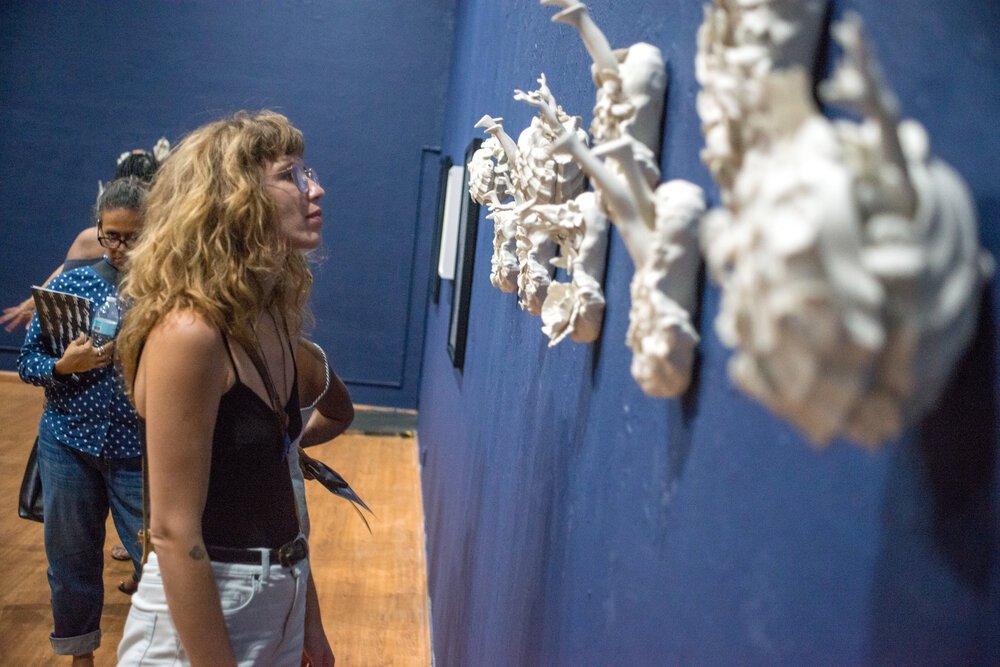Copyright protection notice & permissions:
All works of art on this website in all media, except photography © Morel Doucet. No likeness or near likeness of these works of art in any form may be reproduced or created, in whole or in part, in any medium, without the artist's prior written permission. This copyright is strictly enforced. Contact the artist or gallery to request prior written authorization for image usage.
Represented by Galerie Myrtis.
© 2025. All rights reversed.
Index
Interview with the Artist
Tell us about your WaveMaker project:
My WaveMaker grant support culminated in the exhibition "White Noise: When Raindrops Whisper & Moonlight Screams in Silence," addressing issues of socioeconomic disparity, colorism, and the demise of our coral reef systems and marine biodiversity through climate change. The exhibition title is an allegory of language rooted in magical realism while decoding notions of colonial trauma and societal critique. The exhibition explored the discourse about communities of color plight for change and equal excess, often using allegory to communicate the disparity between necessity and survival.
The exhibition started as a response to the climate crisis in South Florida from blue-green algae, red tides, and the die-off of marine life along both coasts. I used various data and charts from marine and environmental scientists to study the destruction around the state. Based on that data, I started building three-dimensional ceramic work to illustrate this narrative so that the everyday person could understand the impact climate change was having around our state.
As the body of work developed, it was important that I collaborate with a curator and exhibition venue centered in the black community. I reached out to Mikahile Solomon, Director of Prizm Art Fair and the African Heritage Cultural Arts Center. My goal for the exhibition was to develop a holistic body of work where communities of color in Florida were the centerpoint in conversations about seawater rise, climate change, and emergency preparedness.
Working with Mikahile Solomon, and the African Heritage Cultural Arts Center staff was very rewarding. I learned more about the nuances of curating an exhibition; from drafting the exhibition statement, art-handling and installation - aspects artists may under-appreciate in the production of an exhibition.
In the end, I was pleased with the outcome of my exhibition. I was able to bridge conversations with communities of color on the topic of climate change, seawater rise, and emergency preparedness in the event of a climate-exodus from South Florida. During the opening night reception, the African Heritage Cultural Arts Center averaged about 200+ attendees in collaboration with Prizm Art Fair, Sugar Cane Magazine, and social media promotion.
I hope this exhibition can be reimagined into a traveling exhibition throughout Florida and other communities of color that are marginalized and voiceless on issues of climate change and seawater rise.
Tell us what you're most excited about as a result of this project? Has it inspired a new work, collaborations, direction? Has it brought new opportunities for expanding it through other grants or exhibitions? What, where, and when? Tell us more...
After the exhibition at the African Heritage Cultural Arts Center, I am now confident to approach a second solo exhibition. Water grieves in the six shades of death, is a series of mixed media drawings that examine the realities of climate-gentrification, migration, and displacement within South Florida's Black diaspora. The title is rooted in magical realism, juxtaposing water as a body containing historical trauma, cultural dissonance, and active memory.
Within the past two years, I've been exploring Little Haiti, Overtown, Allapattah, and Liberty City to gather various flora and fauna from these communities to create ecological drawings in the forms of abstract portraiture of the residents that live in these districts. When I explore each neighborhood, I see they are in some way, sacred to the people who live there. The land harbors their cultural history, legacies, and shared nostalgia.
Within the last decade developers have been aggressively gentrifying these neighborhoods for elevation and land value; which causes the displacement due to rising rents and property tax. As a result, these communities are changing rapidly. I want to explore the theme of climate-gentrification in South Florida. In the event these Black bodies cease to exist with the threat of climate-gentrification, the land we inhabit still holds our cultural memories and genetics. Tropical foliage and front yard gardens are like gatekeepers of time - they anchor the dreams and hopes of the people.











